Sebaran Spasial Kemunculan (Dugon-Dugong) Sebagai Dasar Pengelolaan Mamalia Laut Di Kabupaten Bangka Selatan
Spatial Distribution of ( Dugong dugon) Appearance as the Basis of Marine Mammal Management in South Bangka Regency
DOI:
https://doi.org/10.33019/akuatik.v15i1.3105Keywords:
Catching, Dugong, South Bangka RegencyAbstract
This study aims to examine the distribution of dugong appearance locations based on fishermen's information, seagrassgrowing areas, fish catchment areas and dugong distribution location in seawater in South Bangka Regency. This
research was observed in February- April 2020 in South Bangka Regency. This research method that used to sampling
were survey method, questionnaire method and interview method with respondent determined based on Slovin formula.
The results showed that the location that dugong appeared in South Bangka Regency, namely Penutuk Island, the
Mempunai Village, Puding Beach, Tukak, Sadai, Kelapan Island, of Lepar Island, Pongok Island, Anak Air Island and
Salma Island. The areas that overgrown by seagrass are Tukak Waters, Sadai, Puding Beach, Tanjung Kerasak Beach,
around small islands such as Kelapan Island, Penutuk Island, Anak Air Island, Pulau Tinggi, Lepar Island, Pongok
Island. The location of fishing catch area is spread evenly around the waters of small islands such as Kelapan Island,
Penutuk Island, Salma Island, Anak Air Island, Pulau Tinggi, Lepar Island, Pongok Island. The distribution of dugongs
based on the RZWP-3-K map showed that 19 points of dugongs appearance were in Marine Conservation Area (KKP),
4 points of dugongs appearance were in fishing zone, 1 point in Port Zone and 5 points were close with the Port Zone.
Downloads
Downloads
Published
Issue
Section
License
Under this license, others are permitted to share (copy and redistribute the material in any medium or format) and adapt (remix, transform, and build upon the material) for any purpose, including commercial use. Appropriate credit must be given to the original authors, a link to the license must be provided, and any modifications or derivative works must be distributed under the same license. This condition ensures that the original work and all derived content remain openly accessible under identical terms.








